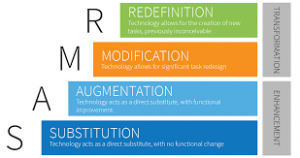
Photo by Ian Schneider on Unsplash
Introduction:
Reading about the Technology, Pedagogy and Content Knowledge (TPACK) model, and the Substitution Augmentation Modification Redefinition (SAMR) model, both as frameworks for incorporating technology into the classroom, gave me cause to pause and reflect on my teaching practices. I thought about how I am implementing technology to enhance students’ learning experiences, while meeting their needs and challenging their skills. Although I could identify with both models, TPACK resonated with me more so than the SAMR model. I see the TPACK model as being more encompassing of students’ learning processes, of my teaching and assessment practices, and of the context in which all of this is occurring. The SAMR model focused more on the final product or outcome, and the different technologies a teacher could use, rather than student learning processes.
TPACK vs. SAMR:
 The TPACK model used to integrate technology into the classroom, focuses on three main areas, including the integration of teacher pedagogy, content knowledge and technology. TPACK identifies the importance of educators using a sound teaching pedagogy and solid knowledge of the content they are teaching. The TPACK model embodies the addition of technology as a supplementary tool, to enhance or compliment students’ learning. TPACK is a model I can see implementing as a method of guidance in my teaching practice. I see this particular model being more holistic, than the SAMR model, as it considers important factors that assist in student success, including the necessity of the educator’s knowledge of the content being taught, the significance of teaching pedagogy that consider a range of student learning processes, and the provision of technology tools to provide support and learning enrichment. TPACK also accounts for the context in which the teaching and learning is occurring. Koehler and Mishra’s article state that TPACK is a “complex interaction among…content, pedagogy and technology [and it is this interaction] that produces the types of flexible learning needed to successfully integrate technology use into teaching” (Koehler, Matthew J. and Mishra P., P.60). Indeed, the “flexible learning”, appeals to me, as it provides room for options when considering the diverse needs of my learners, and my accessibility to resources. Furthermore, TPACK supports me in outlining my teaching strengths and content knowledge within my teaching area. Following the TPACK model will assist me in defining the best teaching methods for my students, the type of assessments I will choose, and the technology tools to facilitate in students’ growth and understanding of the content area. Lastly, the TPACK model, takes into account students’ learning processes, which I believe is important to examine while assessing students’ learning.
The TPACK model used to integrate technology into the classroom, focuses on three main areas, including the integration of teacher pedagogy, content knowledge and technology. TPACK identifies the importance of educators using a sound teaching pedagogy and solid knowledge of the content they are teaching. The TPACK model embodies the addition of technology as a supplementary tool, to enhance or compliment students’ learning. TPACK is a model I can see implementing as a method of guidance in my teaching practice. I see this particular model being more holistic, than the SAMR model, as it considers important factors that assist in student success, including the necessity of the educator’s knowledge of the content being taught, the significance of teaching pedagogy that consider a range of student learning processes, and the provision of technology tools to provide support and learning enrichment. TPACK also accounts for the context in which the teaching and learning is occurring. Koehler and Mishra’s article state that TPACK is a “complex interaction among…content, pedagogy and technology [and it is this interaction] that produces the types of flexible learning needed to successfully integrate technology use into teaching” (Koehler, Matthew J. and Mishra P., P.60). Indeed, the “flexible learning”, appeals to me, as it provides room for options when considering the diverse needs of my learners, and my accessibility to resources. Furthermore, TPACK supports me in outlining my teaching strengths and content knowledge within my teaching area. Following the TPACK model will assist me in defining the best teaching methods for my students, the type of assessments I will choose, and the technology tools to facilitate in students’ growth and understanding of the content area. Lastly, the TPACK model, takes into account students’ learning processes, which I believe is important to examine while assessing students’ learning.

The SAMR model follows a linear or hierarchical path where students move through levels from a beginning or enhancement point, to a higher level of learning, or a transformation stage. I agree with the concept that technology can improve and enhance student learning, as the SAMR model suggests, and the ease of access that technology provides to students, as was demonstrated in the article mLearning by Danae Romrell, Lisa C. Kidder and Emma Wood. However, I do not find the SAMR model as flexible or comprehensive as the TPACK model. SAMR focuses heavily on student product or output, rather than processes made which are an integral part of learning and important to observe. Hamilton’s article states “technology and other instructional tools are intended to play supporting roles in the learning process” (Hamilton et. al., P. 438), which doesn’t seem to be the case in the SAMR model, as there is a push to implement more and more technology to reach a final project. I further agree with Hamilton’s argument that the SAMR model, “underemphasize[s] the multifaceted and complex nature of teaching and learning with technology [and] instead emphasizes the types of technology teachers should use to move themselves up… the [levels of the model] giving primacy to technology rather than good teaching (Hamilton et. al., P. 439). The SAMR model’s simple, hierarchical, design is too simplistic and it does not consider that learning is not a simple process for all learners. Furthermore, this model does not consider outlying factors that can influence students’ learning; whereas the TPACK model does, including teacher’s knowledge of content, their implementation of a sound pedagogy and their access to technology resources. In spite of my dislike for the SAMR model, an area that did stand out for me was the implementation of augmentation. This level is important, and could be used to incorporate different types of available technology, to assist in meeting students’ specific needs. Since I support the TPACK model, this augmentation step could be incorporated within the intersection between Pedagogy and Technology, otherwise known as the Technological Pedagogical Knowledge intersection.
My Implementation of the TPACK Model:

Adopting the TPACK model to integrate technology, is a step I am interested in following. As a Social Studies teacher, I have enjoyed teaching a wide variety of content, specific to grades 10 and 11; and I am comfortable with my knowledge of the content. However, I do collaborate with others in my department to get new ideas or answers to questions. In terms of pedagogy, I always examine what will work best for my class. I recognize, what may have worked for one class may not work for another group of learners in terms of teaching methods and assessment. When working on a project, I may get students to work independently, with a partner or in small groups to research a specific topic, depending on their skill set. Upon finishing their research, students will choose from a variety of options that incorporate technology and take their interests and skills into account, and which further enables them to demonstrate their learning. Presentations of student learning may be represented in various ways, including the development of a web page that can serve as a resource, a video news report, a Prezi with the addition of artifacts or characters created from a 3D printer. Of course there will be criteria that students must meet to demonstrate and evaluate their learning processes along the way, in addition to my own.
Conclusion:
As educators, we face many challenges in our classrooms, including, but not limited to, available resources, learners with diverse needs, and our own knowledge of specific content. I see the overlapping and interconnections, of the three main areas that comprise the TPACK model, supportive of both learning flexibility and teaching. It is this flexibility that supports students in taking pathways to develop their skills and understanding of a concept, and for teachers to choose the best pedagogy to teach specific content. Furthermore, the TPACK model assists educators in identifying and implementing the use of technological tools that best fit with their knowledge, pedagogical practices, and facilitate in students’ learning processes.
Written By: Deirdre Houghton
